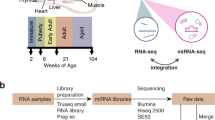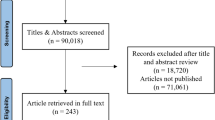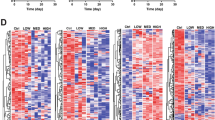Abstract
To validate and extend the findings of the MicroArray Quality Control (MAQC) project, a biologically relevant toxicogenomics data set was generated using 36 RNA samples from rats treated with three chemicals (aristolochic acid, riddelliine and comfrey) and each sample was hybridized to four microarray platforms. The MAQC project assessed concordance in intersite and cross-platform comparisons and the impact of gene selection methods on the reproducibility of profiling data in terms of differentially expressed genes using distinct reference RNA samples. The real-world toxicogenomic data set reported here showed high concordance in intersite and cross-platform comparisons. Further, gene lists generated by fold-change ranking were more reproducible than those obtained by t-test P value or Significance Analysis of Microarrays. Finally, gene lists generated by fold-change ranking with a nonstringent P-value cutoff showed increased consistency in Gene Ontology terms and pathways, and hence the biological impact of chemical exposure could be reliably deduced from all platforms analyzed.
This is a preview of subscription content, access via your institution
Access options
Subscribe to this journal
Receive 12 print issues and online access
$209.00 per year
only $17.42 per issue
Buy this article
- Purchase on Springer Link
- Instant access to full article PDF
Prices may be subject to local taxes which are calculated during checkout





Similar content being viewed by others
Accession codes
References
MAQC Consortium. The MicroArray Quality Control (MAQC) project shows inter- and intraplatform reproducibility of gene expression measurements. Nat. Biotechnol. 24, 1151–1161 (2006).
Shi, L. et al. Cross-platform comparability of microarray technology: intra-platform consistency and appropriate data analysis procedures are essential. BMC Bioinformatics 6 (Suppl 2), S12 (2005).
Chen, L., Mei, N., Yao, L. & Chen, T. Mutations induced by carcinogenic doses of aristolochic acid in kidney of Big Blue transgenic rats. Toxicol. Lett. 165, 250–256 (2006).
Mei, N., Chou, M.W., Fu, P.P., Heflich, R.H. & Chen, T. Differential mutagenicity of riddelliine in liver endothelial and parenchymal cells of transgenic Big Blue rats. Cancer Lett. 215, 151–158 (2004).
Mei, N., Heflich, R.H., Chou, M.W. & Chen, T. Mutations induced by the carcinogenic pyrrolizidine alkaloid riddelliine in the liver cII gene of transgenic Big Blue rats. Chem. Res. Toxicol. 17, 814–818 (2004).
Mei, N., Guo, L., Fu, P.P., Heflich, R.H. & Chen, T. Mutagenicity of comfrey (Symphytum Officinale) in rat liver. Br. J. Cancer 92, 873–875 (2005).
Arlt, V.M., Stiborova, M. & Schmeiser, H.H. Aristolochic acid as a probable human cancer hazard in herbal remedies: a review. Mutagenesis 17, 265–277 (2002).
Patterson, T.A. et al. Performance comparison of one-color and two-color platforms within the MicroArray Quality Control (MAQC) project. Nat. Biotechnol. 24, 1140–1150 (2006).
Allison, D.B., Cui, X., Page, G.P. & Sabripour, M. Microarray data analysis: from disarray to consolidation and consensus. Nat. Rev. Genet. 7, 55–65 (2006).
Tusher, V.G., Tibshirani, R. & Chu, G. Significance analysis of microarrays applied to the ionizing radiation response. Proc. Natl. Acad. Sci. USA 98, 5116–5121 (2001).
Zeeberg, B.R. et al. GoMiner: a resource for biological interpretation of genomic and proteomic data. Genome Biol. 4, R28 (2003).
Zeeberg, B.R. et al. High-Throughput GoMiner, an 'industrial-strength' integrative gene ontology tool for interpretation of multiple-microarray experiments, with application to studies of Common Variable Immune Deficiency (CVID). BMC Bioinformatics 6, 168 (2005).
Stickel, F. & Seitz, H.K. The efficacy and safety of comfrey. Public Health Nutr. 3, 501–508 (2000).
Fu, P.P., Xia, Q., Lin, G. & Chou, M.W. Pyrrolizidine alkaloids–genotoxicity, metabolism enzymes, metabolic activation, and mechanisms. Drug Metab. Rev. 36, 1–55 (2004).
Betz, J.M., Eppley, R.M., Taylor, W.C. & Andrzejewski, D. Determination of pyrrolizidine alkaloids in commercial comfrey products (Symphytum sp.). J. Pharm. Sci. 83, 649–653 (1994).
Cheeke, P.R. Toxicity and metabolism of pyrrolizidine alkaloids. J. Anim. Sci. 66, 2343–2350 (1988).
Huan, J. et al. Dietary pyrrolizidine (Senecio) alkaloids and tissue distribution of copper and vitamin A in broiler chickens. Toxicol. Lett. 62, 139–153 (1992).
Moghaddam, M.F. & Cheeke, P.R. Effects of dietary pyrrolizidine (Senecio) alkaloids on vitamin A metabolism in rats. Toxicol. Lett. 45, 149–156 (1989).
Armendariz, A.D., Gonzalez, M., Loguinov, A.V. & Vulpe, C.D. Gene expression profiling in chronic copper overload reveals upregulation of Prnp and App. Physiol. Genomics 20, 45–54 (2004).
Hesse, L., Beher, D., Masters, C.L. & Multhaup, G. The beta A4 amyloid precursor protein binding to copper. FEBS Lett. 349, 109–116 (1994).
Varela-Nallar, L., Toledo, E.M., Chacon, M.A. & Inestrosa, N.C. The functional links between prion protein and copper. Biol. Res. 39, 39–44 (2006).
Tan, P.K. et al. Evaluation of gene expression measurements from commercial microarray platforms. Nucleic Acids Res. 31, 5676–5684 (2003).
Ramalho-Santos, M., Yoon, S., Matsuzaki, Y., Mulligan, R.C. & Melton, D.A. “Stemness”: transcriptional profiling of embryonic and adult stem cells. Science 298, 597–600 (2002).
Ivanova, N.B. et al. A stem cell molecular signature. Science 298, 601–604 (2002).
Fortunel, N.O. et al. Comment on “'Stemness': transcriptional profiling of embryonic and adult stem cells” and “a stem cell molecular signature”. Science 302, 393 author reply 393 (2003).
Marshall, E. Getting the noise out of gene arrays. Science 306, 630–631 (2004).
Miller, R.M. et al. Dysregulation of gene expression in the 1-methyl-4-phenyl-1,2,3,6-tetrahydropyridine-lesioned mouse substantia nigra. J. Neurosci. 24, 7445–7454 (2004).
Frantz, S. An array of problems. Nat. Rev. Drug Discov. 4, 362–363 (2005).
Tong, W. et al. Evaluation of external RNA controls for the assessment of microarray performance. Nat. Biotechnol. 24, 1132–1139 (2006).
Tong, W. et al. ArrayTrack–supporting toxicogenomic research at the US Food and Drug Administration National Center for Toxicological Research. Environ. Health Perspect. 111, 1819–1826 (2003).
Acknowledgements
E.K.L., K.L.P. and P.H. acknowledge Agilent Technologies, Inc. and Affymetrix, Inc. for their material contributions to this work, thank John Pufky, Stephen Burgin and Jennifer Troehler for their outstanding technical assistance, and gratefully acknowledge the Advanced Technology Program of the National Institute of Standards and Technology, whose generous support provided partial funding of this research (70NANB2H3009). C.W. acknowledges Affymetrix, Inc. for material contributions to this work. R.S. acknowledges technical support of Alan Brunner for generating GE Healthcare microarray data. L.G. and L.S. thank X. Megan Cao, Stacey Dial, Carrie Moland and Feng Qian for their superb technical assistance.
Author information
Authors and Affiliations
Corresponding authors
Ethics declarations
Competing interests
R.S., L.Z. and Y.A.S. declare competing interests on funding. The other authors declare no competing interests.
Supplementary information
Supplementary Fig. 1
Principal component analysis of the platform-specific microarray data separates samples by tissue and treatment. (PDF 203 kb)
Supplementary Fig. 2
Inter-site overlap of differentially expressed gene lists generated using different selection criteria. (PDF 399 kb)
Supplementary Fig. 3
Overlap of differentially expressed gene lists between different normalization methods. (PDF 29 kb)
Supplementary Fig. 4
Inter-site concordance of lists of differentially expressed genes based on fold-change, t-statistic, SAM, and random selection. (PDF 96 kb)
Supplementary Fig. 5
Cross-platform overlap of differentially expressed gene lists generated using different selection criteria. (PDF 1114 kb)
Supplementary Table 1
Summary of RNA Sample Information. (XLS 35 kb)
Supplementary Table 2
Cross-Platform Probe Sequence Mapping (5,112 commonly mapped rat genes). (XLS 1047 kb)
Rights and permissions
About this article
Cite this article
Guo, L., Lobenhofer, E., Wang, C. et al. Rat toxicogenomic study reveals analytical consistency across microarray platforms. Nat Biotechnol 24, 1162–1169 (2006). https://doi.org/10.1038/nbt1238
Received:
Accepted:
Published:
Issue Date:
DOI: https://doi.org/10.1038/nbt1238
This article is cited by
-
Development and validation of an RNA-seq-based transcriptomic risk score for asthma
Scientific Reports (2022)
-
Feeding a Saccharomyces cerevisiae fermentation product improves udder health and immune response to a Streptococcus uberis mastitis challenge in mid-lactation dairy cows
Journal of Animal Science and Biotechnology (2021)
-
Transcriptomic signatures of psychomotor slowing in peripheral blood of depressed patients: evidence for immunometabolic reprogramming
Molecular Psychiatry (2021)
-
Identification of candidate repurposable drugs to combat COVID-19 using a signature-based approach
Scientific Reports (2021)
-
Toxicity testing in the 21st century: progress in the past decade and future perspectives
Archives of Toxicology (2020)



